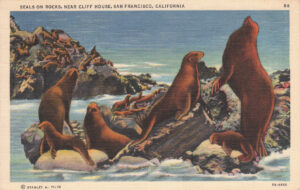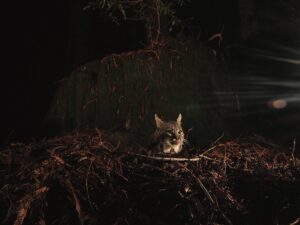Midpen at 50
More pieces in this series exploring the open space district’s history and work.• The Revival of a Clear Creek With old logging roads transformed, clean water and wildlife return to El Corte de Madera.
• Room to Roam Connecting protected spaces is key to wildlife conservation.
• Dancing on the Peak Again The Amah Mutsun hold their first ceremony on Mount Umunhum in two centuries.
• Coexistence: Cattle Ranching Meets Sensitive Species When livestock and conservation needs align.
The Indigenous people of the San Francisco Peninsula were stewarding a wildly biodiverse ecosystem, alive with countless interconnected species, when Don Gaspar de Portolá and his men caught their first sight of the Bay in 1769. Seven years later, the Spanish would colonize the land and establish the region’s first mission—devastating Native populations and beginning 200 years of ever-intensifying resource extraction and development.
Fast-forward to the 1960s, and postwar urban sprawl has consumed the perimeter of the San Francisco Bay. Development creeps steadily from the shoreline to the foothills and toward the mountains. Alarmed by the prospect of losing her community’s last open spaces, a mother of four from Palo Alto named Nonette Hanko seeks solutions at public meetings. When a newspaper editorial suggests forming a special district to protect the undeveloped land, Hanko starts a grassroots campaign from her living room. With support from the Santa Clara County Board of Supervisors, Hanko spearheads an initiative that appears on the ballot in November 1972.
The language of the Room to Breathe Initiative, otherwise known as Measure R, reads more like poetry than policy. “Open space is our green backdrop of hills. It is rolling grasslands, cool forests in the Coast Range, orchards and vineyards in the sun. It is the patch of grass between communities where children can run. It is uncluttered baylands where water birds wheel and soar, where blowing cordgrass yields its blessings of oxygen, where the din of urban life gives way to the soft sounds of nature.”
These words inspire action. The initiative passes with 67.71 percent of the vote, establishing the entity that will become the Midpeninsula Regional Open Space District (or “Midpen”). Its mandate: to protect, preserve, and restore some of the region’s last remaining undeveloped areas as public lands.
A 90-acre purchase that will become Foothills Open Space Preserve kicks off a half-century of work to create an interconnected greenbelt. Over the years, Midpen staff, board members, and volunteers join to protect more than 100 square miles of the region’s most beautiful and ecologically important land. Within that vast space, Midpen establishes 26 open space preserves and more than 250 miles of trail.
Today, Midpen’s expertise extends beyond acquiring land for the public and into the complex work of restoring and sustaining it. It funds studies of local species—from burrowing owls to the marbled murrelet—and awards grants to improve accessibility, interpretation, and education. The Science Advisory Panel provides independent review and guidance as new challenges arise and evolve. Midpen’s Climate Action Plan includes a goal of an 80 percent reduction in operational greenhouse gas emissions by 2050, and the Wildland Fire Resiliency Program promotes fire-adapted ecosystems while planning ahead for a well-coordinated response should Midpen land burn.
“Midpen has matured over the last half-century,” says spokesperson Leigh Ann Gessner. “We implement our full mission in a more balanced way now. We’re focused on connecting the greenbelt and public trail networks, habitat restoration, stewardship, and caring for the land—for example, keeping sediment out of watersheds and making the landscape more resilient to the consequences of climate change.”
In 2012, Midpen launched “Imagine the Future of Open Space,” an 18-month public planning process to create a vision for the next phase of conservation in the region. The passage of Measure AA in 2014 allowed Midpen to begin to realize that vision, authorizing $300 million in bonds over 20 to 30 years to fund hundreds of objectives. The breadth of these projects—from improving transit access to popular preserves in Silicon Valley to protecting agricultural land on the San Mateo Coast—reflects the range of value Midpen lands provide to the Bay Area’s dense and diverse population.
“Midpen was born of community action, validated by the voter, and supported by the public from the very beginning,” Gessner says. “Our legacy will always be tied to community.”

Midpeninsula Regional Open Space District is a public agency whose mission is to acquire and preserve a regional greenbelt of open space land in perpetuity, protect and restore the natural environment, and provide opportunities for ecologically sensitive public enjoyment and education.
On the San Mateo County coast, Midpen’s mission also includes acquiring and preserving in perpetuity open space land and agricultural land of regional significance, preserving rural character, and encouraging viable agricultural use of land resources. OpenSpace.org





